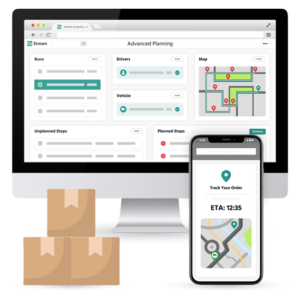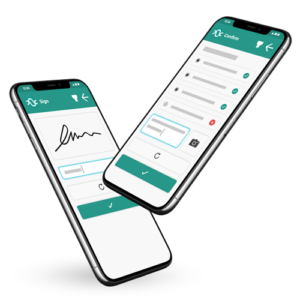With Logistics Management reporting that only around 35% of companies currently have a Transport Management System (TMS) in place and the demand for adopting one continues to grow, Market Growth Reports predicts the compound annual growth rate of the market to be 15.56% from 2024 – 2032 , you may be wondering why they are becoming increasingly popular.
Here we will outline the many functions a TMS has within the supply chain and the numerous benefits it can bring, particularly to a retailer, distributor, or wholesaler.
Transport Management System (TMS) definition
A Transport Management System (often abbreviated to TMS) is an essential part of supply chain logistics that offers a range of functionality to help companies move goods from origin to destination as efficiently as possible in order to reduce costs, boost customer service, and improve sustainability initiatives.
It addresses a number of challenges presented across the supply chain involved with transportation and deliveries, particularly throughout the last mile. Challenges surrounding vehicle capacity, inefficient routing and route management, delivery visibility and traceability, driver and vehicle management, and overall performance across the supply chain.
As Hank Cantiz aptly highlights in Logistics Business IT, “it is shocking to think of a shipper of any size refusing to employ a contemporary system to manage the transportation process.”
Using software applications like Stream to manage your transportation and deliveries provides savings for your company as well as deliver much-improved customer satisfaction.

Key features of a Transport Management System
Transport Management Systems are typically multifaceted; they include a range of features that have been developed to streamline multiple aspects of the supply chain. Which features/functionalities are included in a Transport Management System vary from business to business; however, here’s a list of the most common features:
Intelligent route planning and route optimisation
Logistics planning and route optimisation functionality (and especially automated load planning) are key to transport management. Easily plan routes, factoring in the quickest available route, vehicle capacity, driver availability, and service levels into account automatically. Efficient route planning and optimisation cuts fuel costs by minimising unnecessary mileage and cutting carbon emissions in the process.
Tracking of deliveries, orders, items and drivers
Delivery tracking offers visibility (for both customers and operators) and control throughout the supply chain, ensuring that businesses can monitor the entire transport process and maintain transparency between touchpoints. Transport Management Systems use barcode scanning to track goods passing between these touchpoints, creating an audit trail.
Proof of Delivery (and collection)
Transport routes are typically sent (automatically) directly to a driver’s device, keeping everyone in the loop about planned routes, and letting drivers know exactly where and when they should be making each stop on their route. A driver app is also used to capture ePOD (electronic proof of delivery and collection), so information about each final delivery is recorded and stored digitally in the cloud, heightening operational visibility while reducing a business’ carbon footprint .

Proactive email and SMS delivery notifications and a self-service customer gateway
Another key group of people to keep in the loop, particularly throughout the last mile, is the end customer. Whether you’re planning transport to businesses or directly to consumers, automatically keeping customers informed about their delivery time and providing tracking links keeps them happy, while also minimising missed deliveries and calls to your customer service team.
Monitoring your logistics operation on day of delivery
Back in your planning office or warehouse, everyone can stay up-to-date and informed about the progress of current deliveries by monitoring drivers and their current status, turning an operation from a reactive organisation to a proactive one.
Vehicle checks and vehicle maintenance scheduling
Some TMS can manage the safety, maintenance, and compliance side of transportation management if they have a Walkaround Checks feature and a back-office system that reports and tracks defects through to resolution. Maintaining vehicle safety and roadworthiness is imperative for any fleet in order to keep their vehicles on the road. As the old adage goes, ‘availability is the best ability’.
Order management
Having clear visibility over order and delivery information as it moves through planning, loading, and dispatch, all the way to final delivery in a central location, brings added visibility to the supply chain. A more complex TMS allows this data to be passed between business systems in the form of an integration, ready for planning.
Integrations
One of the core strengths of a TMS is that most on the market offer one-way or two-way integrations with a range of other business systems, such as inventory management and retail management systems like Brightpearl, Sage 50, and Veeqo, to make the TMS a holistic end-to-end process from order through to delivery with minimal intervention. However, the number of systems that they integrate with varies from system to system.
Is it worth investing in a Transport Management System
Through increased operational efficiency, the ROI associated with a feature-rich Transport Management System makes it a worthwhile investment. As mentioned previously, different Systems offer different features and functionality, all at different price points.
Businesses that can use the system effectively can drastically reduce costs, even on more obscure elements that you may not consider, such as phone bills, due to less reliance on customer support teams.
The continued move to the cloud, the importance of sustainability, and the overall improvement in technology should continue to accelerate the growth of the TMS market in the coming years as operators realise the true benefits of such systems and look to remain competitive in their respective marketplaces.
A Transportation Management System (TMS) is specialised logistics software that provides a variety of functionalities to help businesses plan, execute, and optimise the movement of goods across supply chains.
An effective Transportation Management System streamlines your logistics operation, provides real-time supply chain viability and traceability, and ultimately reduces costs. This is achieved through improved shipping efficiency and increased levels of customer satisfaction.
Transport Management Systems utilise delivery-specific route planning and route optimisation features that applications such as Google Maps, Apple Maps, and Waze don’t currently offer. Operations would have to choose and manually input the addresses of each stop in the order they feel would be most efficient and use their routing feature to get from point to point. With a TMS this information can be imported (from an integration with an ERP, for example) and calculated automatically, finding the most efficient route, with the ability to also plan to timeslots.
Customers expect delivery tracking as standard practice whenever they order. Giving them full visibility over the exact location of their purchase as it moves its way through the supply chain is essential, particularly in order to increase delivery success rates. Without delivery tracking, the burden is often placed on customer support teams to manually update customers on the whereabouts of their delivery via phone or text. Transport Management Systems typically include automated SMS or email notifications with tracking links to update customers in real-time.
Operations need electronic Proof of Delivery (ePOD) to replace outdated physical forms or spreadsheets, which often get lost or misplaced, and disrupt information flows. Before adopting a TMS, it is common for operations to use SMS messaging such as Whatsapp to store Proof of Delivery information against orders, which requires manual uploading and lookup as opposed to saving all of the information within one centralise application that captures additional information, such as GPS locations and timestamps.








